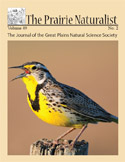Great Plains Natural Science Society

The Prairie Naturalist
Date of this Version
6-2007
Document Type
Article
Citation
The Prairie Naturalist 39(2): June 2007, pp 57-68
Abstract
Distance sampling is a method of estimating population abundance and density used by wildlife biologists for several species because of its advantages relative to other techniques. However, few wildlife biologists have used distance sampling to estimate abundance of white-tailed deer (Odocoileus virginianus). We describe a distance sampling technique used to estimate prehunt and post-hunt population densities of deer in Watonwan County, Minnesota. Estimates of white-tailed deer density were compared between distance sampling versus population modeling, and costs for distance sampling versus aerial surveys were determined. We drove 2,704 km during 24 spotlight surveys conducted from 21 October to 28 December 2004. We observed 537 white-tailed deer during the pre-hunt period and 620 deer during the post-hunt period. Estimates of white-tailed deer density obtained via distance sampling were more than three times larger than estimates derived by population modeling. Costs for aerial surveys would have been four times greater than costs for distance sampling surveys. We concluded that wildlife biologists should consider implementing distance sampling for estimating deer density because of the advantages and lower costs of distance sampling relative to other techniques.
Included in
Biodiversity Commons, Botany Commons, Ecology and Evolutionary Biology Commons, Natural Resources and Conservation Commons, Systems Biology Commons, Weed Science Commons


Comments
Copyright © 2007 The Great Plains Natural Science Society